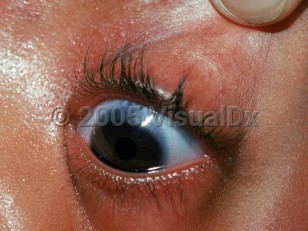Osteogenesis imperfecta in Adult
Alerts and Notices
Important News & Links
Synopsis
Osteogenesis imperfecta refers to a heterogeneous group of inherited qualitative or quantitative defects in collagen type I synthesis, resulting in osteoporosis and frequent fractures. There are at least 8 recognized forms representing a range of severity. Type I is the mildest form and type II is the most severe.
The disorder occurs worldwide but has been reported to have a higher incidence in 2 tribes in Zimbabwe. Most cases are inherited in an autosomal dominant pattern, although spontaneous mutations occur.
Depending upon the type, patients present with fractures in utero or childhood, easy bruising, joint laxity, early onset of deafness, blue sclera, brittle teeth, scoliosis, long limb deformity, and short stature. Depending upon the type, other findings include hernia, mitral valve prolapse, arterial fragility, pulmonary hypertension, and fragile skin. Complications include orthopedic problems, cerebral hemorrhage due to birth trauma, and basilar or cord compression. Many may die of respiratory infections.
Life expectancy depends upon type. Types I and IV have a slight decrease, while most patients with Type II die in the first year. Type III patients have a reduced life expectancy due to skull fractures and respiratory infection but have a reasonable prognosis if surviving beyond age 10.
The disorder occurs worldwide but has been reported to have a higher incidence in 2 tribes in Zimbabwe. Most cases are inherited in an autosomal dominant pattern, although spontaneous mutations occur.
Depending upon the type, patients present with fractures in utero or childhood, easy bruising, joint laxity, early onset of deafness, blue sclera, brittle teeth, scoliosis, long limb deformity, and short stature. Depending upon the type, other findings include hernia, mitral valve prolapse, arterial fragility, pulmonary hypertension, and fragile skin. Complications include orthopedic problems, cerebral hemorrhage due to birth trauma, and basilar or cord compression. Many may die of respiratory infections.
Life expectancy depends upon type. Types I and IV have a slight decrease, while most patients with Type II die in the first year. Type III patients have a reduced life expectancy due to skull fractures and respiratory infection but have a reasonable prognosis if surviving beyond age 10.
Codes
ICD10CM:
Q78.0 – Osteogenesis imperfecta
SNOMEDCT:
78314001 – Osteogenesis imperfecta
Q78.0 – Osteogenesis imperfecta
SNOMEDCT:
78314001 – Osteogenesis imperfecta
Look For
Subscription Required
Diagnostic Pearls
Subscription Required
Differential Diagnosis & Pitfalls

To perform a comparison, select diagnoses from the classic differential
Subscription Required
Best Tests
Subscription Required
Management Pearls
Subscription Required
Therapy
Subscription Required
References
Subscription Required
Last Updated:04/11/2022

